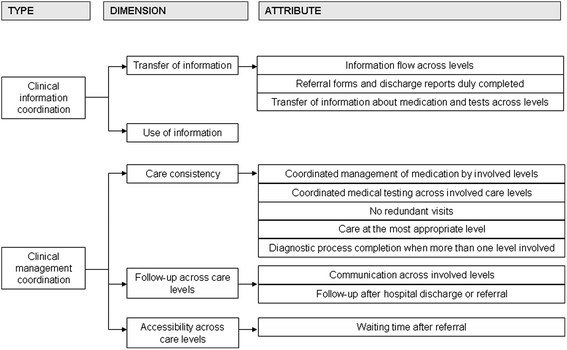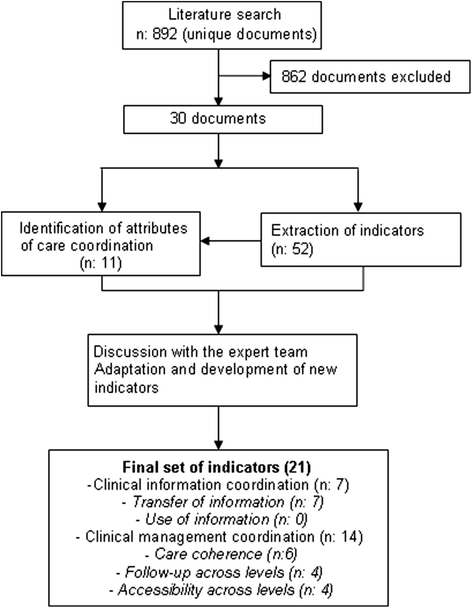Development and testing of indicators to measure coordination of clinical information and management across levels of care
- PMID: 26268694
- PMCID: PMC4535786
- DOI: 10.1186/s12913-015-0968-z
Development and testing of indicators to measure coordination of clinical information and management across levels of care
Abstract
Background: Coordination across levels of care is becoming increasingly important due to rapid advances in technology, high specialisation and changes in the organization of healthcare services; to date, however, the development of indicators to evaluate coordination has been limited. The aim of this study is to develop and test a set of indicators to comprehensively evaluate clinical coordination across levels of care.
Methods: A systematic review of literature was conducted to identify indicators of clinical coordination across levels of care. These indicators were analysed to identify attributes of coordination and classified accordingly. They were then discussed within an expert team and adapted or newly developed, and their relevance, scientific soundness and feasibility were examined. The indicators were tested in three healthcare areas of the Catalan health system.
Results: 52 indicators were identified addressing 11 attributes of clinical coordination across levels of care. The final set consisted of 21 output indicators. Clinical information transfer is evaluated based on information flow (4) and the adequacy of shared information (3). Clinical management coordination indicators evaluate care coherence through diagnostic testing (2) and medication (1), provision of care at the most appropriate level (2), completion of diagnostic process (1), follow-up after hospital discharge (4) and accessibility across levels of care (4). The application of indicators showed differences in the degree of clinical coordination depending on the attribute and area.
Conclusion: A set of rigorous and scientifically sound measures of clinical coordination across levels of care were developed based on a literature review and discussion with experts. This set of indicators comprehensively address the different attributes of clinical coordination in main transitions across levels of care. It could be employed to identify areas in which health services can be improved, as well as to measure the effect of efforts to improve clinical coordination in healthcare organizations.
Figures
References
-
- Reid R, Haggerty J, McKendry R. Defusing the confusion: concepts and measures of continuity of healthcare. Ottawa: Canadian Health Services Research Foundation; 2002.
-
- Starfield BH. Atención primaria. [Primary Care: Balancing Health Needs, Services, and Technology] Barcelona: Masson, S.A.; 2001.
-
- Nolte E, McKee M. Caring for people with chronic conditions. A health system perspective. Maidenhead: European Observatory on Health Systems and Policies Series. Mc Graw Hill, Open University Press; 2008.
-
- Longest B, Young G. Coordination and communication. In: Shortell SM, Kaluzny AD, editors. Health care managment. Organization design and behavior. Albany, NY: Delmar; 2000. pp. 210–243.
Publication types
MeSH terms
LinkOut - more resources
Full Text Sources
Other Literature Sources



